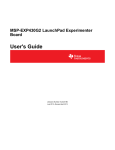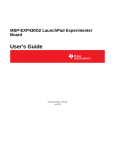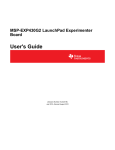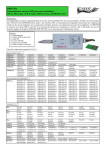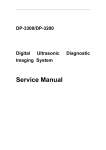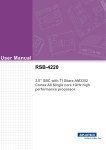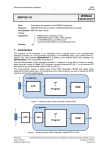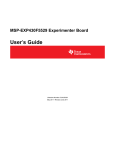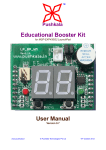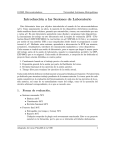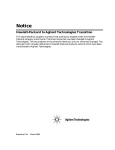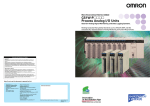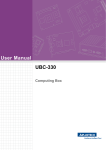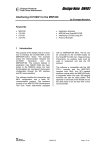Download MSP-EXP430G2 LaunchPad Evaluation Kit
Transcript
MSP-EXP430G2 LaunchPad Evaluation Kit User's Guide Literature Number: SLAU318F July 2010 – Revised January 2015 Contents 1 MSP-EXP430G2 LaunchPad Overview .................................................................................... 4 .................................................................................................................. 4 1.2 Features ................................................................................................................... 5 1.3 Kit Contents ............................................................................................................... 5 1.4 Revisions .................................................................................................................. 6 2 Installation .......................................................................................................................... 6 2.1 Download the Required Software ...................................................................................... 6 2.2 Install the Software ....................................................................................................... 6 2.3 Install the Hardware...................................................................................................... 6 3 Getting Started With MSP-EXP430G2 LaunchPad..................................................................... 7 3.1 Getting Started ........................................................................................................... 7 3.2 Demo Application, Internal Temperature Measurement ............................................................ 7 4 Develop an Application With the MSP-EXP430G2 LaunchPad.................................................... 8 4.1 Developing an Application .............................................................................................. 8 4.2 Program and Debug the Temperature Measurement Demo Application ......................................... 8 4.3 Disconnect Emulator From Target With Jumper J3 ................................................................. 9 4.4 Program Connected eZ430 Target Boards.......................................................................... 10 4.5 Connecting a Crystal Oscillator ....................................................................................... 11 4.6 Connecting a BoosterPack ............................................................................................ 11 4.7 Supported Devices ..................................................................................................... 11 4.8 MSP-EXP430G2 On-Board Emulator ................................................................................ 13 5 MSP-EXP430G2 Hardware ................................................................................................... 13 5.1 Device Pinout ........................................................................................................... 13 5.2 Schematics .............................................................................................................. 14 5.3 PCB Layout .............................................................................................................. 20 5.4 Bill of Materials (BOM) ................................................................................................. 23 6 Suggested Reading ............................................................................................................ 24 7 Frequently Asked Questions (FAQ) ...................................................................................... 24 Revision History .......................................................................................................................... 26 1.1 2 Overview Table of Contents SLAU318F – July 2010 – Revised January 2015 Submit Documentation Feedback Copyright © 2010–2015, Texas Instruments Incorporated www.ti.com List of Figures 1 MSP-EXP430G2 LaunchPad Overview................................................................................... 5 2 Insert Device Into Target Socket 3 4 5 6 7 8 9 10 11 12 13 14 .......................................................................................... 8 Code Composer Studio™ v4 in Debugging Mode ...................................................................... 9 MSP-EXP430G2 LaunchPad With Attached eZ430-RF2500 Target Board ........................................ 10 Device Pinout ............................................................................................................... 13 Schematics, MSP-EXP430G2 Emulator (1 of 2), Revision 1.4 ...................................................... 14 Schematics, MSP-EXP430G2 Emulator (2 of 2), Revision 1.4 ...................................................... 15 Schematics, MSP-EXP430G2 Target Socket, Revision 1.4 .......................................................... 16 Schematics, MSP-EXP430G2 Emulator (1 of 2), Revision 1.5 ...................................................... 17 Schematics, MSP-EXP430G2 Emulator (2 of 2), Revision 1.5 ...................................................... 18 Schematics, MSP-EXP430G2 Target Socket, Revision 1.5 .......................................................... 19 Layout, LaunchPad Top Layer ........................................................................................... 20 Layout, LaunchPad Bottom Layer........................................................................................ 21 Layout, LaunchPad Silkscreen ........................................................................................... 22 List of Tables 1 Jumper Connection J3 Between Emulator and Target ................................................................. 9 2 eZ430 Debugging Interface ............................................................................................... 10 3 Supported Devices ......................................................................................................... 11 4 Features Supported by On-Board Emulator ............................................................................ 13 5 Bill of Materials ............................................................................................................. SLAU318F – July 2010 – Revised January 2015 Submit Documentation Feedback Copyright © 2010–2015, Texas Instruments Incorporated List of Figures 23 3 User's Guide SLAU318F – July 2010 – Revised January 2015 MSP-EXP430G2 LaunchPad Evaluation Kit Preface: Read This First If You Need Assistance If you have any feedback or questions, support for the MSP430™ devices and the MSP-EXP430G2 is provided by the Texas Instruments Product Information Center (PIC) and the TI E2E Forum (http://e2e.ti.com/). Contact information for the PIC can be found on the TI web site at http://support.ti.com. Additional device-specific information can be found on the MSP430 web site at http://www.ti.com/msp430. Related Documentation from Texas Instruments The primary sources of MSP430 information are the device-specific data sheets and user's guides available at the Texas Instruments MSP430 web site: http://www.ti.com/msp430. MSP430 device user's guides, application reports, software examples and other MSP430 user's guides can be found at the Tech Docs section. The CCS user's guide includes detailed information on setting up a project and using Code Composer Studio™ for the MSP430 microcontroller (SLAU157). Information specific to the MSP-EXP430G2 LaunchPad Evaluation Kit, all the available IDEs, Software Libraries, and examples can be found at the Tools & Software section: http://www.ti.com/tool/mspexp430g2. 1 MSP-EXP430G2 LaunchPad Overview 1.1 Overview The MSP-EXP430G2 LaunchPad is an inexpensive and simple evaluation kit for the MSP430G2xx Value Line series of microcontrollers. It is an easy way to start developing on the MSP430 with on-board emulation for programming and debugging as well as buttons and LEDs for a simple user interface. Rapid prototyping is simplified by the 20-pin BoosterPack headers which support a wide range of available BoosterPack plug-in modules. You can quickly add features like wireless connectivity, graphical displays, environmental sensing, and much more. You can either design your own BoosterPack or choose among many already available from TI and third party developers. The LaunchPad features an integrated DIP target socket that supports up to 20 pins, allowing MSP430™ Value Line devices to be plugged into the LaunchPad board. The MSP-EXP430G2 LaunchPad comes with an MSP430G2553 device by default. The MSP430G2553 has the most memory available of the compatible Value Line devices. The MSP430G2553 16-bit MCU has 16KB flash, 512 bytes RAM, up to 16-MHz CPU speed, 10-bit ADC, capacitive touch enabled I/Os, universal serial communication interface, and more – plenty to get you started in your development. Free software development tools are also available: TI's Eclipse-based Code Composer Studio™ IDE (CCS), IAR Embedded Workbench™ IDE (IAR), and the community-driven Energia open source code editor. More information about the LaunchPad, including documentation and design files, can be found on the tool page at http://www.ti.com/tool/msp-exp430g2. MSP430, Code Composer Studio are trademarks of Texas Instruments. IAR Embedded Workbench is a trademark of IAR Systems. All other trademarks are the property of their respective owners. 4 MSP-EXP430G2 LaunchPad Evaluation Kit SLAU318F – July 2010 – Revised January 2015 Submit Documentation Feedback Copyright © 2010–2015, Texas Instruments Incorporated MSP-EXP430G2 LaunchPad Overview www.ti.com 1.2 Features MSP-EXP430G2 LaunchPad features: • USB debugging and programming interface featuring a driverless installation and application UART serial communication with up to 9600 Baud • Supports MSP430G2xx2, MSP430G2xx3, and MSP430F20xx devices in PDIP14 or PDIP20 packages (see Section 4.7 for a complete list of supported devices) • Two general-purpose digital I/O pins connected to green and red LEDs for visual feedback • Two push button for user feedback and device reset • Easily accessible device pins for debugging purposes or as socket for adding customized extension boards • High-quality 20-pin DIP socket for an easy plug-in or removal of the target device Figure 1. MSP-EXP430G2 LaunchPad Overview 1.3 Kit Contents The MSP-EXP430G2 evaluation kit includes the following hardware: • LaunchPad emulator socket board (MSP-EXP430G2) • Mini USB-B cable, 0.5 m • Two MSP430 flash devices – MSP430G2553: Low-power 16-bit MSP430 microcontroller with an 8-channel 10-bit ADC, on-chip comparator, touch-sense enabled I/Os, universal serial communication interface, 16kB flash memory, and 512 bytes of RAM (preloaded with a sample program) – MSP430G2452: Low-power 16-bit MSP430 microcontroller with an 8-channel 10-bit ADC, on-chip comparator, touch-sense enabled I/Os, universal serial interface, 8kB flash memory, and 256 bytes of SRAM • Two 10-pin PCB connectors female • 32.768-kHz clock crystal from Micro Crystal (http://www.microcrystal.com) • Quick start guide • Two LaunchPad stickers SLAU318F – July 2010 – Revised January 2015 Submit Documentation Feedback MSP-EXP430G2 LaunchPad Evaluation Kit Copyright © 2010–2015, Texas Instruments Incorporated 5 MSP-EXP430G2 LaunchPad Overview 1.4 www.ti.com Revisions The first production revision of the LaunchPad in 2010 was 1.3. In 2012 the LaunchPad board revision changed from 1.4 to 1.5 to align with the new release of Value Line devices. The differences in the schematic and the kit contents are: • Layout and Schematic: – Voltage feedback in the emulator changed to increase startup stability (Rev 1.3 to Rev 1.4) – Rearranged jumper J3 to support two UART configurations: vertical (SW UART), horizontal (HW UART) – VCC on the connector J4 can now be disconnected from the emulator VCC by J3 – Pullup resistor R34 and capacitor C24 on P1.3 removed to reduce the current consumption – Presoldered male headers J1 and J2 2 Installation The MSP-EXP430G2 LaunchPad installation consists of three easy steps: 1. Download the required software. 2. Install the selected IDE. 3. Connect the LaunchPad to the PC. Then the LaunchPad is ready to develop applications or to use the pre-programmed demo application. 2.1 Download the Required Software Different development software tools are available for the MSP-EXP430G2 LaunchPad development board. IAR Embedded Workbench™ KickStart IDE and Code Composer Studio™ (CCS) IDE are both available in a free limited version. IAR Embedded Workbench allows 4KB of C-code compilation. CCS is limited to a code size of 16KB. The software is available at http://www.ti.com/mspds. There are many other compilers and integrated development environments (IDEs) available to use with the MSP-EXP430 LaunchPad including Rowley Crossworks and MSPGCC. However, example projects have been created using IAR Embedded Workbench KickStart IDE and Code Composer Studio IDE (CCS). For more information on the supported software and the latest code examples, visit the LaunchPad tool page (http://www.ti.com/tool/msp-exp430g2). 2.2 Install the Software Download one of the integrated development environments (IDEs) (see Section 2.1). IAR KickStart and CCS offer the required driver support to work with the MSP-EXP430 LaunchPad onboard emulation. Once installed, the IDE should find the MSP-EXP430G2 LaunchPad as USB:HID debugging interface. Now all is set for developing MSP430G2xx based application on the LaunchPad. 2.3 Install the Hardware Connect the MSP-EXP430G2 LaunchPad socket board with the enclosed USB cable to a PC. The driver installation starts automatically. If prompted for software, allow Windows to install the software automatically. This is possible only if either IAR KickStart or CCS is already installed. 6 MSP-EXP430G2 LaunchPad Evaluation Kit SLAU318F – July 2010 – Revised January 2015 Submit Documentation Feedback Copyright © 2010–2015, Texas Instruments Incorporated Getting Started With MSP-EXP430G2 LaunchPad www.ti.com 3 Getting Started With MSP-EXP430G2 LaunchPad 3.1 Getting Started The first time the MSP-EXP430G2 LaunchPad Evaluation Kit is used, a demo application automatically starts as soon as the board is powered from the USB host. To start the demo, connect the MSPEXP430G2 LaunchPad with the included mini USB cable to a free USB port. The demo application starts with an LED toggle to show the device is active. More information about the demo application can be found in Section 3.2. 3.2 Demo Application, Internal Temperature Measurement The LaunchPad includes a pre-programmed MSP430G2553 device already installed in the target socket. When LaunchPad is connected via USB, the demo starts with an LED toggle sequence. The onboard emulation generates the supply voltage and all the signals necessary to start. Press button P1.3 to switch the application to a temperature measurement mode. A reference temperature is taken at the beginning of this mode, and the LEDs of the LaunchPad signal a rise or fall in temperature by varying the brightness of the on-board red or green LED, respectively. The reference temperature can also be recalibrated with another button press on P1.3. The collected temperature data is also communicated via back-channel UART through the USB emulation circuitry back to the PC. The internal temperature sensor data from the MSP430G2553 device is sent to the PC to be displayed on the GUI. The pre-loaded demo application and the GUI are found in the Software Examples zip folder. The GUI is opened with LaunchPad_Temp_GUI.exe. This GUI is made with Processing (http://processing.org) with the source available for customization. The serial communication port on the PC must be configured with 2400 bps, one stop bit, and no flow control to display the values correctly. The demo application uses the on-chip peripherals of the MSP430G2553 device such as the 10-bit ADC, which samples the internal temperature sensor, and 16-bit timers, which drive the PWM to vary brightness of the LEDs and enable software UART for communication with the PC. The MSP430G2553 offers a USCI interface that is capable of communicating through UART at up to 2 MBaud, but to be aligned with all the other MSP430G2xx devices, the demo uses the Timer UART implementation, which can be used on all the other devices. This way the demo can be used with any other MSP430G2xx device with an integrated ADC, without any change in the program. The provided applications can be a great starting point for various custom applications and give a good overview of the various applications of the MSP430G2xx Value Line devices. SLAU318F – July 2010 – Revised January 2015 Submit Documentation Feedback MSP-EXP430G2 LaunchPad Evaluation Kit Copyright © 2010–2015, Texas Instruments Incorporated 7 Develop an Application With the MSP-EXP430G2 LaunchPad www.ti.com 4 Develop an Application With the MSP-EXP430G2 LaunchPad 4.1 Developing an Application The integrated development environments (IDEs) shown in Section 2 offer support for the whole MSP430G2xx Value Line. The MSP-EXP430G2 LaunchPad needs only a connection to the USB of the Host PC—there is no external hardware required. The power supply and the Spy-Bi-Wire JTAG signals TEST and RST must be connected with jumper J3 to allow the onboard emulation connection to the device. Now the preferred device can be plugged into the DIP target socket of the LaunchPad (see Figure 2). Both PDIP14 and PDIP20 devices of the MSP430G2xx Value Line and the MSP430F20xx family can be inserted into the DIP socket aligned to pin 1. A complete list of supported devices can be found in Section 4.7. Figure 2. Insert Device Into Target Socket The following example for Code Composer Studio shows how to download and debug the demo application described in Section 3.2. 4.2 Program and Debug the Temperature Measurement Demo Application The source code of the demo application can be found in the Software Examples zip folder. Download the project folder and unpack it to a location of your choice. For this demo, Code Composer Studio v4 or newer must be installed. The demo application can be loaded to the CCS workspace by clicking File→Import. Select the location of the extracted project files and import Existing projects into Workspace. Now the MSP-EXP430G2Launchpad project appears inside the CCS workspace. The project must be marked as the active project to start programming and debugging the device. Connect the LaunchPad with an inserted MSP430G2553 device to the host PC and click the Debug button on the CCS Toolbar. The MSP-EXP430G2 LaunchPad is initialized and the download of the compiled demo application starts. The CCS view switches to a debugging interface once the download is completed and the application is ready to start. Figure 3 shows Code Composer Studio v4 with the MSP-EXP430G2 LaunchPad demo application in debug view. 8 MSP-EXP430G2 LaunchPad Evaluation Kit SLAU318F – July 2010 – Revised January 2015 Submit Documentation Feedback Copyright © 2010–2015, Texas Instruments Incorporated Develop an Application With the MSP-EXP430G2 LaunchPad www.ti.com Figure 3. Code Composer Studio™ v4 in Debugging Mode 4.3 Disconnect Emulator From Target With Jumper J3 The connection between the MSP-EXP430G2 emulator and the attached target device can be opened with the jumper array J3. This can be useful to access an attached eZ430 target board by disconnecting the Spi-Bi-Wire JTAG lines RST and TEST or if the JTAG lines are used for other application purposes. The jumper array can also be used to measure the power consumption of the LaunchPad application. For this intention, all connections except VCC must be opened, and a multi meter can used on the VCC Jumper to measure the current of the MSP-EXP430G2 target device and its peripherals. The jumper J5 VCC also must be opened if the LaunchPad board is powered with an external power supply over J6 Table 1 or the eZ430 interface J4. NOTE: The assignment of jumper J3 has been changed in MSP-EXP430G2 revision 1.5, see the comments in Table 1 to find the assignment for a specific board revision. Table 1. Jumper Connection J3 Between Emulator and Target Jumper Signal 1 VCC Target socket power supply voltage (power consumption test jumper) (located on 5 before Rev. 1.5) Description 2 TEST Test mode for JTAG pins or Spy-Bi-Wire test clock input during programming and test (located on 1 before Rev. 1.5) 3 RST Reset or Spy-Bi-Wire test data input/output during programming and test (located on 2 before Rev. 1.5) 4 RXD UART receive data input (direction can be selected by jumper orientation) (located on 3 before Rev. 1.5) 5 TXD UART transmit data output (direction can be selected by jumper orientation) (located on 4 before Rev. 1.5) Jumpers 4 and 5 connect the UART interface of the emulator to the target device pins P1.1 and P1.2. These jumpers can be used to select between a software (SW) UART or a hardware (HW) UART by their orientation. In vertical orientation (SW UART), the jumpers connect the emulation TXD signal to target P1.2 and the emulation RXD signal to target P1.1, as they are used for the software UART communication on the demo application (see Section 2.2). In horizontal orientation (HW UART), the jumpers connect the SLAU318F – July 2010 – Revised January 2015 Submit Documentation Feedback MSP-EXP430G2 LaunchPad Evaluation Kit Copyright © 2010–2015, Texas Instruments Incorporated 9 Develop an Application With the MSP-EXP430G2 LaunchPad www.ti.com emulator TXD signal to target P1.1 and the emulator RXD to target P1.2, as required for the USCI module. Keep in mind that UART communication is full duplex, so connections are made for both transmit and receive on each side, and the labeling is specific to what action each side of the UART bus is performing. For example, the emulator TXD (transmit) signal connects to the target RXD (receive) signal, and the emulator RXD signal connects to the target TXD signal. 4.4 Program Connected eZ430 Target Boards The MSP-EXP430G2 LaunchPad can program the eZ430-RF2500T target boards, the eZ430-Chronos watch module, or the eZ430-F2012T/F2013T. To connect one of the ez430 targets, connector J4 must be populated with a 0.050-in (1.27-mm) pitch male header, as shown in Figure 4. Figure 4. MSP-EXP430G2 LaunchPad With Attached eZ430-RF2500 Target Board To program the attached target without interfering with the LaunchPad socket board, jumper connections TEST and RST of J3 must be open. The interface to the eZ430 target board is always connected to the MSP-EXP430G2 emulator, so the programming and debugging of a connected LaunchPad target device is possible only if the eZ430 target is not connected on the same time. The application UART, on the other hand, is connected directly to the LaunchPad target device, and jumper J3 can be closed to monitor the transmission from the LaunchPad target to the attached eZ430. This way both possible connections, from the device to the PC and from the device to the eZ430, can be established without changing the direction of the UART pins. The VCC connection to the eZ430 interface is directly connected to the LaunchPad target VCC and can be separated with jumper J3, if the LaunchPad itself should be powered via a connected battery on J4. To supply the eZ430 interface with the onboard emulator the jumper J3 VCC needs to be closed. Table 2 shows the pinout of the eZ430 debugging interface J4, the first pin is the left pin located on the emulator part of the LaunchPad. Table 2. eZ430 Debugging Interface Pin 10 Signal Description 1 TXD UART transmit data output (UART communication from PC or MSP430G2xx to eZ430 target board) 2 VCC Power supply voltage (J3 VCC needs to be closed to supply via onboard emulator) 3 TEST / SBWTCK Test mode for JTAG pins and Spy-Bi-Wire test clock input during programming and test 4 RST / SBWTDIO Reset, Spy-Bi-Wire test data input/output during programming and test 5 GND Power supply ground 6 RXD UART receive data input (UART communication from eZ430 target board to PC or MSP430G2xx) MSP-EXP430G2 LaunchPad Evaluation Kit SLAU318F – July 2010 – Revised January 2015 Submit Documentation Feedback Copyright © 2010–2015, Texas Instruments Incorporated Develop an Application With the MSP-EXP430G2 LaunchPad www.ti.com 4.5 Connecting a Crystal Oscillator The MSP-EXP430G2 LaunchPad offers a footprint for a variety of crystal oscillators. The XIN and XOUT signals of the LFXT1 oscillator can support low-frequency oscillators like a watch crystals of 32768 Hz or a standard crystal with a range defined in the associated data sheet. The signal lines XIN and XOUT can also be used as multipurpose I/Os or as a digital frequency input. More information on the possibilities of the low-frequency oscillator and the possible crystal selection can be found in the MSP430x2xx Family User's Guide (SLAU144) or the device-specific data sheet. The oscillator signals are connected to J2 to use the signals on an attached application board. In case of signal distortion of the oscillator signals that leads to a fault indication at the basic clock module, resistors R29 and R28 can be used to disconnect the pin header J2 from the oscillating lines. 4.6 Connecting a BoosterPack The LaunchPad can connect to many BoosterPacks within the ecosystem. The BoosterPack headers J1 and J2 along with power supply J6 fall on a 100-mil (0.1-in) grid to allow for easy and inexpensive development with a breadboard. The LaunchPad adheres to the 20-pin LaunchPad pinout standard. A standard was created to aid compatibility between LaunchPads and BoosterPacks, across the TI ecosystem. The 20-pin standard is backward compatible with the 40-pin standard used by LaunchPads like the MSPEXP430F5529LP. This allows a subset of some 40-pin BoosterPacks to be used with 20-pin LaunchPads. While most BoosterPacks are compliant with the standard, some are not. The LaunchPad is compatible with all 20-pin (and 40-pin) BoosterPacks that are compliant with the standard. If the reseller or owner of the BoosterPack does not explicitly indicate compatibility with the MSP430G2 LaunchPad, you might want to compare the schematic of the candidate BoosterPack with the LaunchPad, to ensure compatibility. Keep in mind that sometimes conflicts can be resolved by changing the G2 device pin function configuration in software. More information about compatibility can also be found at http://www.ti.com/launchpad. 4.7 Supported Devices Texas Instruments offers several MSP430 devices in a PDIP package that is compatible with LaunchPad. Table 3 shows the supported devices. Table 3. Supported Devices Part Number Family Description MSP430F2001 F2xx 16-bit Ultra-Low-Power Microcontroller, 1KB Flash, 128B RAM, Comparator MSP430F2002 F2xx 16-bit Ultra-Low-Power Microcontroller, 1KB Flash, 128B RAM, 10-Bit SAR A/D, USI for SPI/I2C MSP430F2003 F2xx 16-bit Ultra-Low-Power Microcontroller, 1KB Flash, 128B RAM, 16-Bit Sigma-Delta A/D, USI for SPI/I2C MSP430F2011 F2xx 16-bit Ultra-Low-Power Microcontroller, 2KB Flash, 128B RAM, Comparator MSP430F2012 F2xx 16-bit Ultra-Low-Power Microcontroller, 2KB Flash, 128B RAM, 10-Bit SAR A/D, USI for SPI/I2C MSP430F2013 F2xx 16-bit Ultra-Low-Power Microcontroller, 2KB Flash, 128B RAM, 16-Bit Sigma-Delta A/D, USI for SPI/I2C MSP430G2001 G2xx 16-bit Ultra-Low-Power Microcontroller, 512B Flash, 128B RAM MSP430G2101 G2xx 16-bit Ultra-Low-Power Microcontroller, 1KB Flash, 128B RAM MSP430G2111 G2xx 16-bit Ultra-Low-Power Microcontroller, 1KB Flash, 128B RAM, Comparator MSP430G2121 G2xx 16-bit Ultra-Low-Power Microcontroller, 1KB Flash, 128B RAM, USI for SPI/I2C MSP430G2131 G2xx 16-bit Ultra-Low-Power Microcontroller, 1KB Flash, 128B RAM, 10-Bit SAR A/D, USI for SPI/I2C MSP430G2201 G2xx 16-bit Ultra-Low-Power Microcontroller, 2KB Flash, 128B RAM MSP430G2211 G2xx 16-bit Ultra-Low-Power Microcontroller, 2KB Flash, 128B RAM, Comparator MSP430G2221 G2xx 16-bit Ultra-Low-Power Microcontroller, 2KB Flash, 128B RAM, USI for SPI/I2C MSP430G2231 G2xx 16-bit Ultra-Low-Power Microcontroller, 2KB Flash, 128B RAM, 10-Bit SAR A/D, USI for SPI/I2C MSP430G2102 G2xx 16-bit Ultra-Low-Power Microcontroller, 1KB Flash, 256B RAM, USI for SPI/I2C, 16 Capacitive-Touch Enabled I/O Pins MSP430G2202 G2xx 16-bit Ultra-Low-Power Microcontroller, 2KB Flash, 256B RAM, USI for SPI/I2C, 16 Capacitive-Touch Enabled I/O Pins SLAU318F – July 2010 – Revised January 2015 Submit Documentation Feedback MSP-EXP430G2 LaunchPad Evaluation Kit Copyright © 2010–2015, Texas Instruments Incorporated 11 Develop an Application With the MSP-EXP430G2 LaunchPad www.ti.com Table 3. Supported Devices (continued) Part Number 12 Family Description MSP430G2302 G2xx 16-bit Ultra-Low-Power Microcontroller, 4KB Flash, 256B RAM, USI for SPI/I2C, 16 Capacitive-Touch Enabled I/O Pins MSP430G2402 G2xx 16-bit Ultra-Low-Power Microcontroller, 8KB Flash, 256B RAM, USI for SPI/I2C, 16 Capacitive-Touch Enabled I/O Pins MSP430G2112 G2xx 16-bit Ultra-Low-Power Microcontroller, 1KB Flash, 256B RAM, Comparator, USI for SPI/I2C, 16 Capacitive-Touch Enabled I/O Pins MSP430G2212 G2xx 16-bit Ultra-Low-Power Microcontroller, 2KB Flash, 256B RAM, Comparator, USI for SPI/I2C, 16 Capacitive-Touch Enabled I/O Pins MSP430G2312 G2xx 16-bit Ultra-Low-Power Microcontroller, 4KB Flash, 256B RAM, Comparator, USI for SPI/I2C, 16 Capacitive-Touch Enabled I/O Pins MSP430G2412 G2xx 16-bit Ultra-Low-Power Microcontroller, 8KB Flash, 256B RAM, Comparator, USI for SPI/I2C, 16 Capacitive-Touch Enabled I/O Pins MSP430G2132 G2xx 16-bit Ultra-Low-Power Microcontroller, 1KB Flash, 256B RAM, 10-Bit SAR A/D, USI for SPI/I2C, 16 Capacitive-Touch Enabled I/O Pins MSP430G2232 G2xx 16-bit Ultra-Low-Power Microcontroller, 2KB Flash, 256B RAM, 10-Bit SAR A/D, USI for SPI/I2C, 16 Capacitive-Touch Enabled I/O Pins MSP430G2332 G2xx 16-bit Ultra-Low-Power Microcontroller, 4KB Flash, 256B RAM, 10-Bit SAR A/D, USI for SPI/I2C, 16 Capacitive-Touch Enabled I/O Pins MSP430G2432 G2xx 16-bit Ultra-Low-Power Microcontroller, 8KB Flash, 256B RAM, 10-Bit SAR A/D, USI for SPI/I2C, 16 Capacitive-Touch Enabled I/O Pins MSP430G2152 G2xx 16-bit Ultra-Low-Power Microcontroller, 1KB Flash, 256B RAM, 10-Bit SAR A/D, Comparator, USI for SPI/I2C, 16 Capacitive-Touch Enabled I/O Pins MSP430G2252 G2xx 16-bit Ultra-Low-Power Microcontroller, 2KB Flash, 256B RAM, 10-Bit SAR A/D, Comparator, USI for SPI/I2C, 16 Capacitive-Touch Enabled I/O Pins MSP430G2352 G2xx 16-bit Ultra-Low-Power Microcontroller, 4KB Flash, 256B RAM, 10-Bit SAR A/D, Comparator, USI for SPI/I2C, 16 Capacitive-Touch Enabled I/O Pins MSP430G2452 G2xx 16-bit Ultra-Low-Power Microcontroller, 8KB Flash, 256B RAM, 10-Bit SAR A/D, Comparator, USI for SPI/I2C, 16 Capacitive-Touch Enabled I/O Pins MSP430G2153 G2xx 16-bit Ultra-Low-Power Microcontroller, 1KB Flash, 256B RAM, 10-Bit SAR A/D, Comparator, USCI for I2C/SPI/UART, 24 Capacitive-Touch Enabled I/O Pins MSP430G2203 G2xx 16-bit Ultra-Low-Power Microcontroller, 2KB Flash, 256B RAM, Comparator, USCI for I2C/SPI/UART, 24 Capacitive-Touch Enabled I/O Pins MSP430G2313 G2xx 16-bit Ultra-Low-Power Microcontroller, 2KB Flash, 256B RAM, Comparator, USCI for I2C/SPI/UART, 24 Capacitive-Touch Enabled I/O Pins MSP430G2333 G2xx 16-bit Ultra-Low-Power Microcontroller, 2KB Flash, 256B RAM, 10-Bit SAR A/D, Comparator, USCI for I2C/SPI/UART, 24 Capacitive-Touch Enabled I/O Pins MSP430G2353 G2xx 16-bit Ultra-Low-Power Microcontroller, 2KB Flash, 256B RAM, 10-Bit SAR A/D, Comparator, USCI for I2C/SPI/UART, 24 Capacitive-Touch Enabled I/O Pins MSP430G2403 G2xx 16-bit Ultra-Low-Power Microcontroller, 8KB Flash, 512B RAM,, Comparator, USCI for I2C/SPI/UART, 24 Capacitive-Touch Enabled I/O Pins MSP430G2413 G2xx 16-bit Ultra-Low-Power Microcontroller, 8KB Flash, 512B RAM, Comparator, USCI for I2C/SPI/UART, 24 Capacitive-Touch Enabled I/O Pins MSP430G2433 G2xx 16-bit Ultra-Low-Power Microcontroller, 8KB Flash, 512B RAM, 10-Bit SAR A/D, Comparator, USCI for I2C/SPI/UART, 24 Capacitive-Touch Enabled I/O Pins MSP430G2453 G2xx 16-bit Ultra-Low-Power Microcontroller, 8KB Flash, 512B RAM, 10-Bit SAR A/D, Comparator, USCI for I2C/SPI/UART, 24 Capacitive-Touch Enabled I/O Pins MSP430G2513 G2xx 16-bit Ultra-Low-Power Microcontroller, 16KB Flash, 512B RAM, Comparator, USCI for I2C/SPI/UART, 24 Capacitive-Touch Enabled I/O Pins MSP430G2533 G2xx 16-bit Ultra-Low-Power Microcontroller, 16KB Flash, 512B RAM, 10-Bit SAR A/D, Comparator, USCI for I2C/SPI/UART, 24 Capacitive-Touch Enabled I/O Pins MSP430G2553 G2xx 16-bit Ultra-Low-Power Microcontroller, 16KB Flash, 512B RAM, 10-Bit SAR A/D, Comparator, USCI for I2C/SPI/UART, 24 Capacitive-Touch Enabled I/O Pins MSP-EXP430G2 LaunchPad Evaluation Kit SLAU318F – July 2010 – Revised January 2015 Submit Documentation Feedback Copyright © 2010–2015, Texas Instruments Incorporated Develop an Application With the MSP-EXP430G2 LaunchPad www.ti.com 4.8 MSP-EXP430G2 On-Board Emulator The MSP-EXP430G2 on-board emulator enables programming and debugging of supported MSP430 devices (see Section 4.7). It offers several features that are enabled by a 2-wire JTAG interface called Spy-Bi-Wire. For a more feature-complete emulator, the MSP-FET430UIF flash emulation tool may be more appropriate. See Table 4 for more details on the MSP-EXP430G2 LaunchPad on-board emulator. Table 4. Features Supported by On-Board Emulator Support by LaunchPad (MSP-EXP430G2) Feature ✓ Supports MSP430F20xx, F21x2, F22xx, G2x01, G2x11, G2x21, G2x31, G2x53 Allows fuse blow Adjustable target supply voltage Fixed 2.8-V target supply voltage ✓ Fixed 3.6-V target supply voltage 4-wire JTAG 2-wire JTAG ✓ Application UART ✓ Supported by CCS ✓ Supported by IAR ✓ 5 MSP-EXP430G2 Hardware 5.1 Device Pinout Figure 5. Device Pinout SLAU318F – July 2010 – Revised January 2015 Submit Documentation Feedback MSP-EXP430G2 LaunchPad Evaluation Kit Copyright © 2010–2015, Texas Instruments Incorporated 13 TP6TP4TP2 TP7TP5TP3TP1 GND GND GND EZ_VBUS RESET C1 10n RESET R1 47k C2 16p EZ_VCC C3 16p Q1 12MHz 64 63 62 61 60 59 58 57 56 55 54 53 52 51 50 49 17 18 19 20 21 22 23 24 25 26 27 28 29 30 31 32 HTCK HTMS HTDI HTDO C5 100n 1 2 3 4 5 6 7 8 9 10 11 12 13 14 15 16 48 47 46 45 44 43 42 41 40 39 38 37 36 35 34 33 R2 47k GND R3 47k RST3410 BRXDI BTXDI URXD UTXD R4 R5 R6 R7 100R 100R 100R 100R J3 9 7 5 3 1 CLK3410 EZ_VCC TEST/SBWTCK RST/SBWTDIO P1.2 P1.1 VCC SBW & UART I/F to Argon SBWTCK 10 SBWTDIO 8 6 BTXD 4 BRXD EZ_VCC 2 1 2 3 4 5 6 SL127L6TH J4 SBW & UART I/F to external Target P1.1 EZ_VCC SBWTCK SBWTDIO GND P1.2 Removed U2: SN75240PW from SBW connections Copyright © 2010–2015, Texas Instruments Incorporated C4 1u/6.3V EZ_VCC R26 270 LED0 green GND URTS UDTR UDSR UCTS SCL SDA MSP-EXP430G2 EMULATOR 1/2 1.4 SLAU318F – July 2010 – Revised January 2015 Submit Documentation Feedback MSP-EXP430G2 LaunchPad Evaluation Kit 14 Schematics 5.2 www.ti.com MSP-EXP430G2 Hardware Figure 6. Schematics, MSP-EXP430G2 Emulator (1 of 2), Revision 1.4 MSP-EXP430G2 Hardware www.ti.com RST3410 1u/6.3V C8 EZ_VCC R16 47k GND DNP BRXDI BTXDI CLK3410 SCL SDA R10 10k R11 15k EZ_VCC UTXD URXD R25 1k5 R23 100R R17 DNP 47k R24 1k5 EZ_VCC R12 33k D1 1N4148 R19 3k3 R22 3k3 GND 1 9 12 2 22 17 19 10 11 32 31 30 29 27 26 VREGEN RESET WAKEUP SUSPEND CLKOUT U3 SCL SDA WC E1 C13 100n PUR DP DM CTS DSR DCD RI/CP RTS DTR TEST0 TEST1 VCC VCC1 VDD18 GND GND1 GND2 C11 100n 6 5 8 7 CAT24FC32UI VSS VCC E2 E0 U5 TUSB3410VF SIN SOUT 4 3 2 1 SDA SCL P3.0 P3.1 P3.3 P3.4 X1 X2 GND 5 6 7 13 14 15 16 20 21 23 24 3 25 4 8 18 28 R13 1k5 GND EZ_VCC C12 100n GND UCTS UDSR URTS UDTR EZ_VCC R18 100k/1% R20 100k/1% C9 22p GND EZ_VBUS C7 100n GND GND R15 33R R14 33R C10 22p GND 5 6 3 4 GND U2 IN1 OUT1 IN2 OUT2 FB GND RES EN 8 7 1 2 TPS77301DGK RESET VCC = +3.6V R8 61k5 R9 33k EZ_VCC C6 USB_MINI_B5 SHIELD4 SHIELD3 SHIELD2 SHIELD1 GND ID D+ D- VBUS Mini USB Connector U$2 1u/6.3V GND 2 1 GND EZ_D- S4 S3 S2 S1 5 4 3 EZ_VBUS R21 33k EZ_D+ GND MSP-EXP430G2 EMULATOR 2/2 1.4 Copyright © 2010–2015, Texas Instruments Incorporated 15 MSP-EXP430G2 LaunchPad Evaluation Kit SLAU318F – July 2010 – Revised January 2015 Submit Documentation Feedback 4 2 5 3 1 GND NC IO2 IO1 VCC Figure 7. Schematics, MSP-EXP430G2 Emulator (2 of 2), Revision 1.4 0R R29 DNP R28 XIN VCC GND XOUT P1.0 P1.6 J1 1 2 3 4 5 6 7 8 9 10 R34 47K VCC P1.0 P1.1 P1.2 P1.3 P1.4 P1.5 P2.0 P2.1 P2.2 20 19 18 17 16 15 14 13 12 11 S2 GND P1.3 20 19 18 17 16 15 14 13 12 11 J2 MSP-EXP430G2 TARGET SOCKET GND XIN XINR XOUTR XOUT TEST/SBWTCK RST/SBWTDIO P1.7 P1.6 P2.5 P2.4 P2.3 R27 GND 47K 1 2 1 2 RST/SBWTDIO 20 Pin Socket IC1 1 2 3 4 5 6 7 8 9 10 Socket: TBD Type: TBD S1 Ext_PWR J6 GND C23 10uF/10V C21 12pF 270R 0R R32 J5-1 R33 J5-2 470R C14 1nF DNP DNP C22 12pF LED1 green LED2 red GND DNP C24 100nF 1 2 3 GND 1 2 3 4 C20 100nF QUARZ5 Q2 1.4 SLAU318F – July 2010 – Revised January 2015 Submit Documentation Feedback MSP-EXP430G2 LaunchPad Evaluation Kit 16 www.ti.com MSP-EXP430G2 Hardware Figure 8. Schematics, MSP-EXP430G2 Target Socket, Revision 1.4 Copyright © 2010–2015, Texas Instruments Incorporated MSP-EXP430G2 Hardware www.ti.com GND GND GND EZ_VBUS RESET 1 2 3 4 5 6 7 8 9 10 11 12 13 14 15 16 C1 10n RESET R1 47k C2 16p EZ_VCC C3 16p Q1 12MHz 64 63 62 61 60 59 58 57 56 55 54 53 52 51 50 49 17 18 19 20 21 22 23 24 25 26 27 28 29 30 31 32 HTCK HTMS HTDI HTDO C5 100n URTS UDTR UDSR UCTS 48 47 46 45 44 43 42 41 40 39 38 37 36 35 34 33 R2 47k GND R3 47k RST3410 BRXDI BTXDI URXD UTXD SCL SDA R4 R5 R6 R7 100R 100R 100R 100R CLK3410 EZ_VCC VCC TEST/SBWTCK RST/SBWTDIO P1.2 BRXD SBW & UART I/F to Argon 9 7 5 3 1 1 2 3 4 5 6 SL127L6TH J4 SBW & UART I/F to external Target J3 changed on Rev 1.5 EZ_VCC 10 SBWTCK 8 SBWTDIO 6 4 BTXD 2 P1.1 BRXD BTXD P1.1 VCC SBWTCK SBWTDIO GND P1.2 MSP-EXP430G2 EMULATOR 1/2 1.5 Copyright © 2010–2015, Texas Instruments Incorporated C4 1u/6.3V EZ_VCC R26 270 GND LED0 green 17 MSP-EXP430G2 LaunchPad Evaluation Kit SLAU318F – July 2010 – Revised January 2015 Submit Documentation Feedback TP6TP4TP2 TP7TP5TP3TP1 Figure 9. Schematics, MSP-EXP430G2 Emulator (1 of 2), Revision 1.5 RST3410 1u/6.3V C8 EZ_VCC R16 47k GND DNP BRXDI BTXDI CLK3410 SCL SDA R10 10k R11 15k R12 33k D1 1N4148 R19 3k3 R22 3k3 GND 1 9 12 2 22 17 19 10 11 32 31 30 29 27 26 VREGEN RESET WAKEUP SUSPEND CLKOUT U3 E1 SCL SDA WC 100n PUR DP DM CTS DSR DCD RI/CP RTS DTR TEST0 TEST1 VCC VCC1 VDD18 GND GND1 GND2 C11 100n 6 5 8 7 CAT24FC32UI VSS VCC E2 E0 U5 TUSB3410VF SIN SOUT SDA SCL P3.0 P3.1 P3.3 P3.4 X1 X2 2 1 3 4 C13 5 6 7 13 14 15 16 20 21 23 24 3 25 4 8 18 28 R13 1k5 GND EZ_VCC C12 100n GND UCTS UDSR URTS UDTR EZ_VCC R18 100k/1% R20 100k/1% C9 22p GND EZ_VBUS C7 100n GND GND R15 33R R14 33R C10 22p GND 5 6 4 3 GND U2 IN1 OUT1 IN2 OUT2 EN FB GND RES 8 7 1 2 TPS77301DGK RESET VCC = +3.6V R8 61k5 R9 30k EZ_VCC C6 USB_MINI_B5 SHIELD4 SHIELD3 SHIELD2 SHIELD1 GND ID D+ D- VBUS Mini USB Connector U$2 1u/6.3V GND 2 1 GND EZ_D- S4 S3 S2 S1 5 4 3 EZ_VBUS R21 33k EZ_D+ GND MSP-EXP430G2 EMULATOR 2/2 1.5 Copyright © 2010–2015, Texas Instruments Incorporated EZ_VCC UTXD URXD R25 1k5 R23 100R R17 DNP 47k R24 1k5 EZ_VCC GND 4 2 5 3 1 GND NC IO2 IO1 VCC SLAU318F – July 2010 – Revised January 2015 Submit Documentation Feedback MSP-EXP430G2 LaunchPad Evaluation Kit 18 www.ti.com MSP-EXP430G2 Hardware Figure 10. Schematics, MSP-EXP430G2 Emulator (2 of 2), Revision 1.5 MSP-EXP430G2 Hardware www.ti.com R29 0R DNP R28 0R R32 J5-1 270R R33 J5-2 470R XIN VCC GND XOUT P1.0 P1.6 J1 1 2 3 4 5 6 7 8 9 10 DNP VCC P1.0 P1.1 P1.2 P1.3 P1.4 P1.5 P2.0 P2.1 P2.2 R34 47K GND 20 19 18 17 16 15 14 13 12 11 20 Pin Socket IC1 1 2 3 4 5 6 7 8 9 10 Socket: TBD Type: TBD R27 47K RST/SBWTDIO GND GND XIN XINR XOUTR XOUT TEST/SBWTCK RST/SBWTDIO P1.7 P1.6 P2.5 P2.4 P2.3 S1 GND 20 19 18 17 16 15 14 13 12 11 S2 P1.3 J2 MSP-EXP430G2 TARGET SOCKET 1.5 Copyright © 2010–2015, Texas Instruments Incorporated 2 1 2 1 Ext_PWR J6 GND C21 12pF DNP DNP C22 12pF LED1 green LED2 red C14 1nF C23 10uF/10V GND C24 100nF 19 MSP-EXP430G2 LaunchPad Evaluation Kit SLAU318F – July 2010 – Revised January 2015 Submit Documentation Feedback 1 2 3 4 C20 100nF QUARZ5 Q2 1 2 3 Figure 11. Schematics, MSP-EXP430G2 Target Socket, Revision 1.5 MSP-EXP430G2 Hardware 5.3 www.ti.com PCB Layout Figure 12. Layout, LaunchPad Top Layer 20 MSP-EXP430G2 LaunchPad Evaluation Kit SLAU318F – July 2010 – Revised January 2015 Submit Documentation Feedback Copyright © 2010–2015, Texas Instruments Incorporated MSP-EXP430G2 Hardware www.ti.com Figure 13. Layout, LaunchPad Bottom Layer SLAU318F – July 2010 – Revised January 2015 Submit Documentation Feedback MSP-EXP430G2 LaunchPad Evaluation Kit Copyright © 2010–2015, Texas Instruments Incorporated 21 MSP-EXP430G2 Hardware www.ti.com Figure 14. Layout, LaunchPad Silkscreen 22 MSP-EXP430G2 LaunchPad Evaluation Kit SLAU318F – July 2010 – Revised January 2015 Submit Documentation Feedback Copyright © 2010–2015, Texas Instruments Incorporated MSP-EXP430G2 Hardware www.ti.com 5.4 Bill of Materials (BOM) Table 5. Bill of Materials Ref Name Number per Board 1 C2, C3 2 16pF 0402 (33 pF on Rev 1.3) 2 C9, C10 2 22pF 0402 3 C1 1 10nF 0402 4 C5, C7, C11, C12, C13 5 100nF 0402 5 C4, C6, C8 3 1µF, 6.3V 0604 6 D1 1 1N4148 MicroMELF 7 EZ_USB 1 Mini-USB connector 8 Q1 1 SMD oscillator 12 MHz 9 R1, R2, R3, R16, R17 3 47k 0402 (R16, R17 is not populated) 10 R8 1 61k5 0402 (6k8 in Rev 1.3 and prior) 11 R19, R22 2 3k3 0402 12 R9 1 30k 0402 (3k3 in Rev 1.3 and prior) 13 R12, R21 2 33k 0402 14 R4, R5, R6, R7, R23 5 100R 0402 15 R14, R15 2 33R 0402 16 R18, R20 2 100k 0402 17 R13, R24, R25 3 1k5 0402 18 R10 1 10k 0402 19 R11 1 15k 0402 20 U1 1 MSP430F1612IPMR 21 U4 1 TPD2E001DRLR 22 U3 1 TUSB3410VF 23 U2 1 TPS77301DGKR 24 U5 1 I2C EEPROM 128k (AT24C128-10TU-2.7) 25 TP1, TP2, TP3, TP4, TP5, TP6, TP7 1 1nF, SMD 0603 Pos. Description 26 C14 27 C21, C22 28 C23 1 10µF, 10 V, SMD 0805 29 C20, C24 1 100nF, SMD 0603 (C24 is not populated) 30 LED0, LED1 2 Green DIODE 0603 31 LED2 1 Red DIODE 0603 32 R34, R27 1 47k SMD 0603 (R34 is not populated) 33 R32, R26 2 270R SMD 0603 34 R33 1 470R SMD 0603 35 R28, R29 2 0R SMD 0603 36 IC1 1 DIP20 socket 37 Q2 38 J1, J2, 2 10-pin header, TH, 2.54mm male (female header included) 39 J3 1 2X05 pin header male 40 J4 41 J5 1 2x02 pin header male 42 J6 2 3-pin header, male, TH 43 S1, S2 2 Push button 12.5pF, SMD 0603 (not populated) Clock crystal 32kHz (Micro Crystal MS3V-T1R 32.768kHz CL:12.5pF ±20ppm included) 6 pin header male 1.28mm SLAU318F – July 2010 – Revised January 2015 Submit Documentation Feedback MSP-EXP430G2 LaunchPad Evaluation Kit Copyright © 2010–2015, Texas Instruments Incorporated 23 Suggested Reading 6 www.ti.com Suggested Reading The primary sources of MSP430™ information are the device-specific data sheets and the family user's guides. The most up-to-date versions of those documents can be found at the Texas Instruments MSP430 landing page. For more information on CCS and IAR, download the latest version from http://www.ti.com/mspds and read the included user's guides and documentation in the installation folder. Documents describing the IAR tools (Workbench/C-SPY, the assembler, the C compiler, the linker, and the library) are located in common\doc and 430\doc. All necessary CCS documents can be found in the msp430\doc folder in the CCS installation path. The FET user's guide also includes detailed information on how to set up a project for the MSP430 using IAR or CCS, and it is included in most of the IDE releases and on the TI MSP430 side. 7 Frequently Asked Questions (FAQ) 1. Can other programming tools like the MSP-FET430UIF interface the MSP-EXP430G2 LaunchPad socket device? The LaunchPad evaluation kit works with any programming tool that supports the 2-wire Spy-Bi-Wire interface. Both the MSP430 USB FET (MSP-FET430UIF) and the Gang Programmer (MSP-GANG430) support these devices, but the connection must be made directly to the dedicated Spy-Bi-Wire ports. See MSP-FET430 Flash Emulation Tool User's Guide (SLAU138) for details on using MSP430 USB FET and the Gang Programmer for a 2-wire Spy-Bi-Wire interface. Do not try to connect the standard JTAG connector to the MSP-EXP430G2 pinheads, as this could result in damage to the attached hardware. 2. Does the MSP-EXP430G2 support fuse blow? The MSP-EXP430G2 LaunchPad evaluation kit onboard debugging interface lacks the JTAG security fuse-blow capability. To ensure firmware security on devices going to production, the USB Flash Emulation Tool or the Gang Production Programmer, which support the fuse-blow feature, are recommended. 3. What versions of IAR Embedded Workbench and Code Composer Studio are supported? The MSP-EXP430G2 LaunchPad hardware is supported by IAR Embedded Workbench KickStart Version 6.00 or higher and Code Composer Studio v4 or higher. To download the IDE visit http://www.ti.com/mspds. 4. What are the part numbers for the connectors between the LaunchPad emulator board and the other eZ430 target boards? Header: MALE CONN HEADER .050" 6POS PCB R/A (for example, Digi-Key: S9016E-06-ND) Socket: FEMALE CONN HEADER .050" 6POS PCB R/A (for example, Digi-Key: S9010E-06-ND) 5. I am not able to select the MSP430 Application UART and cannot receive data. Ensure that the Application UART driver is correctly installed. This is done by installing either IAR Embedded Workbench or Code Composer Studio v4. To determine if the driver is correctly installed: a. Plug in the MSP-EXP430G2 LaunchPad with the included Mini USB cable. b. Right click My Computer and select Properties. c. Select the Hardware tab and click on Device Manager. d. Under Ports (COM & LPT) should be an entry for "MSP430 Application UART (COM xx)". If the entry is there, but no characters are received, reconnect the LaunchPad to the PC and restart the application to reload the drivers. If the Application UART is not listed, install the driver by following the instructions in Section 2.2. If the application UART is installed but not receiving UART data, ensure that the jumpers on J3 are configured for the proper UART communication. The two UART jumpers are configured vertically for a software (SW) UART, and horizontally for a hardware (HW) UART. The application implementation and J3 jumpers should match for UART data to be properly transmitted. 24 MSP-EXP430G2 LaunchPad Evaluation Kit SLAU318F – July 2010 – Revised January 2015 Submit Documentation Feedback Copyright © 2010–2015, Texas Instruments Incorporated Frequently Asked Questions (FAQ) www.ti.com 6. The device is not answering to any communication, JTAG or UART. If you are experiencing difficulties in communicating to the attached MSP430 target device, even though all the communication drivers for the MSP-EXP430G2 are loaded correctly, the emulator is probably set to a wrong communication state. This can be fixed by reconnecting the LaunchPad evaluation kit and restarting the communicating application. Also make sure that all the jumpers on J3 are connected properly between the emulator and the target device. On revision 1.5 and newer, the orientation of the UART jumpers must align with the software implementation on the target device. 7. I soldered the 32-kHz crystal to the board and the oscillation is not starting. The MSP430 driving capabilities for the low-frequency crystal is limited, because it is designed for lowpower applications. To ensure proper operation, the load on these pins must be as small as possible, the matching capacitors (12.5 pF for 32.768 kHz) for the crystal must be soldered to the board, and the resistors R28 and R29 must be removed. Measuring the frequency of the oscillation with an oscilloscope typically disturbs the oscillation. 8. The power consumption of the board is much higher than specified in the device data sheet, or I am not measuring a current at all. The MSP430 device inside of the LaunchPad socket can be powered with an external power supply at header J6 or J4. To measure the power consumption in this mode, the VCC jumper, usually used to measure the power consumption, must be removed, and the current must be measured directly at the power supply. If the jumper J3 is not removed, the emulator circuitry of the LaunchPad is powered as well. Measuring the current consumption during a debug session is not possible, because the cross current through the JTAG connection influences the measurement. The most accurate results are achieved with all jumpers on J3 removed. If the measurement is still not matching the data sheet parameters, make sure that the code is aligned with all the power saving recommendations on the web site MSP430™ - The World's Lowest Power MCU. LaunchPad revisions 1.3 and 1.4 come with R34 populated. The 47-kΩ resistor is used as a pullup for the button S2. If the port P1.3 is driven to ground, as suggested to keep the power consumption down, the pullup resistor generates an additional current of approximately 77 µA. To reduce the power consumption, the port should stay in input mode or the resistor should be removed if button S2 is not used. The internal pullup of the MSP430G2xx can be used instead. SLAU318F – July 2010 – Revised January 2015 Submit Documentation Feedback MSP-EXP430G2 LaunchPad Evaluation Kit Copyright © 2010–2015, Texas Instruments Incorporated 25 Revision History www.ti.com Revision History Changes from E Revision (March 2014) to F Revision ................................................................................................... Page • Corrected the description of jumper settings in the paragraph that starts "Jumpers 4 and 5 connect the UART interface..." ................................................................................................................................. 9 NOTE: Page numbers for previous revisions may differ from page numbers in the current version. 26 Revision History SLAU318F – July 2010 – Revised January 2015 Submit Documentation Feedback Copyright © 2010–2015, Texas Instruments Incorporated IMPORTANT NOTICE Texas Instruments Incorporated and its subsidiaries (TI) reserve the right to make corrections, enhancements, improvements and other changes to its semiconductor products and services per JESD46, latest issue, and to discontinue any product or service per JESD48, latest issue. Buyers should obtain the latest relevant information before placing orders and should verify that such information is current and complete. All semiconductor products (also referred to herein as “components”) are sold subject to TI’s terms and conditions of sale supplied at the time of order acknowledgment. TI warrants performance of its components to the specifications applicable at the time of sale, in accordance with the warranty in TI’s terms and conditions of sale of semiconductor products. Testing and other quality control techniques are used to the extent TI deems necessary to support this warranty. Except where mandated by applicable law, testing of all parameters of each component is not necessarily performed. TI assumes no liability for applications assistance or the design of Buyers’ products. Buyers are responsible for their products and applications using TI components. To minimize the risks associated with Buyers’ products and applications, Buyers should provide adequate design and operating safeguards. TI does not warrant or represent that any license, either express or implied, is granted under any patent right, copyright, mask work right, or other intellectual property right relating to any combination, machine, or process in which TI components or services are used. Information published by TI regarding third-party products or services does not constitute a license to use such products or services or a warranty or endorsement thereof. Use of such information may require a license from a third party under the patents or other intellectual property of the third party, or a license from TI under the patents or other intellectual property of TI. Reproduction of significant portions of TI information in TI data books or data sheets is permissible only if reproduction is without alteration and is accompanied by all associated warranties, conditions, limitations, and notices. TI is not responsible or liable for such altered documentation. Information of third parties may be subject to additional restrictions. Resale of TI components or services with statements different from or beyond the parameters stated by TI for that component or service voids all express and any implied warranties for the associated TI component or service and is an unfair and deceptive business practice. TI is not responsible or liable for any such statements. Buyer acknowledges and agrees that it is solely responsible for compliance with all legal, regulatory and safety-related requirements concerning its products, and any use of TI components in its applications, notwithstanding any applications-related information or support that may be provided by TI. Buyer represents and agrees that it has all the necessary expertise to create and implement safeguards which anticipate dangerous consequences of failures, monitor failures and their consequences, lessen the likelihood of failures that might cause harm and take appropriate remedial actions. Buyer will fully indemnify TI and its representatives against any damages arising out of the use of any TI components in safety-critical applications. In some cases, TI components may be promoted specifically to facilitate safety-related applications. With such components, TI’s goal is to help enable customers to design and create their own end-product solutions that meet applicable functional safety standards and requirements. Nonetheless, such components are subject to these terms. No TI components are authorized for use in FDA Class III (or similar life-critical medical equipment) unless authorized officers of the parties have executed a special agreement specifically governing such use. Only those TI components which TI has specifically designated as military grade or “enhanced plastic” are designed and intended for use in military/aerospace applications or environments. Buyer acknowledges and agrees that any military or aerospace use of TI components which have not been so designated is solely at the Buyer's risk, and that Buyer is solely responsible for compliance with all legal and regulatory requirements in connection with such use. TI has specifically designated certain components as meeting ISO/TS16949 requirements, mainly for automotive use. In any case of use of non-designated products, TI will not be responsible for any failure to meet ISO/TS16949. Products Applications Audio www.ti.com/audio Automotive and Transportation www.ti.com/automotive Amplifiers amplifier.ti.com Communications and Telecom www.ti.com/communications Data Converters dataconverter.ti.com Computers and Peripherals www.ti.com/computers DLP® Products www.dlp.com Consumer Electronics www.ti.com/consumer-apps DSP dsp.ti.com Energy and Lighting www.ti.com/energy Clocks and Timers www.ti.com/clocks Industrial www.ti.com/industrial Interface interface.ti.com Medical www.ti.com/medical Logic logic.ti.com Security www.ti.com/security Power Mgmt power.ti.com Space, Avionics and Defense www.ti.com/space-avionics-defense Microcontrollers microcontroller.ti.com Video and Imaging www.ti.com/video RFID www.ti-rfid.com OMAP Applications Processors www.ti.com/omap TI E2E Community e2e.ti.com Wireless Connectivity www.ti.com/wirelessconnectivity Mailing Address: Texas Instruments, Post Office Box 655303, Dallas, Texas 75265 Copyright © 2015, Texas Instruments Incorporated



























